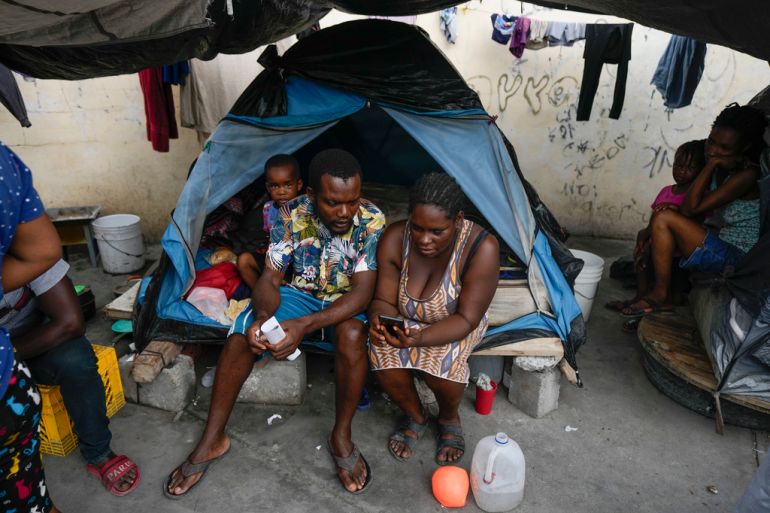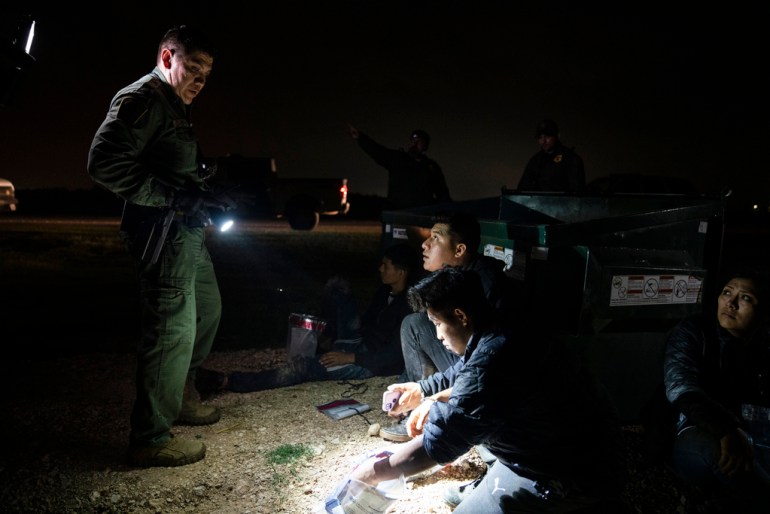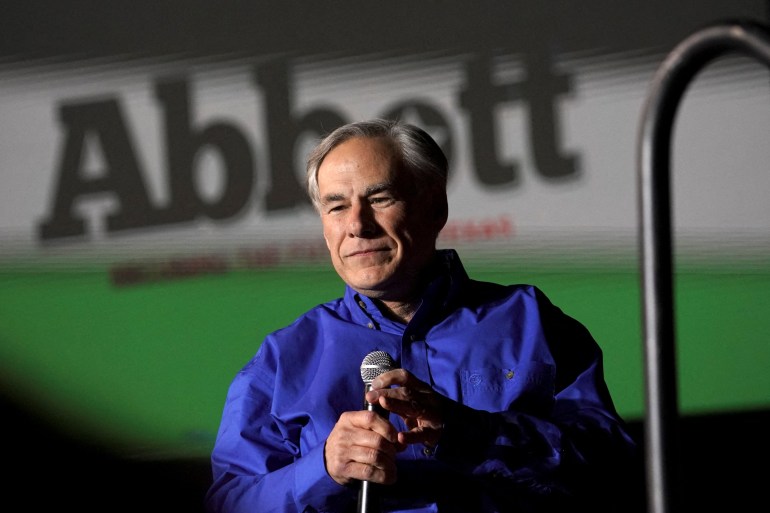Title 42 is about to expire in US. Here’s what you need to know
Expiry of contentious US policy will bring little relief to asylum seekers facing many other border curbs, experts say.

The United States policy known as Title 42 will expire in a matter of hours, bringing one of the country’s most controversial border restrictions to an end more than two years after it was first imposed under the pretext of public health.
US officials are expecting to see an uptick in the number of migrants and refugees attempting to enter the country through the border with Mexico when Title 42 formally expires late on Thursday.
Keep reading
list of 3 items‘I feel powerless’: Asylum seekers lament Title 42’s extension
US Supreme Court upholds controversial Title 42 border policy
However, amid pressure from Republican legislators to stem border crossings, the administration of US President Joe Biden has deployed additional troops and imposed new curbs in preparation for the end of the COVID-era restriction.
This has drawn concern from rights groups that accuse Washington of cracking down on asylum, a right recognised under both US and international law.
Here, Al Jazeera examines how Title 42 has worked, what impact the policy has had on migration at the US’s southern border, and what to expect when it ends.

Where does Title 42 come from?
Title 42 is derived from a previously obscure US public health law that dates back to 1944.
It was first invoked in March 2020 by former President Donald Trump’s administration, which argued it was necessary to stem the spread of COVID-19. Rights groups have said, however, that this was merely a pretext to crack down on immigration.
How has the policy been used?
Title 42 has allowed US authorities to rapidly turn away most migrants and refugees who arrive at the country’s southern border, without giving them an opportunity to apply for protection.
Since it was first put in place, the US has recorded more than 2.8 million Title 42 expulsions, according to government figures. This includes people who may have been turned away multiple times.
When exactly will it end?
The policy is set to expire on Thursday at 11:59pm ET (03:59 GMT on Friday).
This coincides with the end of the COVID-19 public health emergency in the US on May 11.
Had Washington tried to end Title 42 before this?
Yes. The Biden administration attempted to lift the policy last year after the US Centers for Disease Control and Prevention (CDC) said Title 42 was no longer necessary to respond to the pandemic.
However, Republican-led states filed a lawsuit arguing that it was needed to prevent a massive influx of migrants and refugees at the border. A protracted legal fight ensued, but with the pandemic health emergency order ending this month, that is now moot.
What has the Biden administration done to prepare?
The White House announced last week that it was sending 1,500 more US troops to the Mexico border in anticipation of the expiration of Title 42. This is in addition to the 2,500 soldiers already deployed there.
White House spokesperson Karine Jean-Pierre said on Tuesday that the Biden administration was ready to handle an expected surge in migration.
“Right now we believe we have a robust plan, a multi-agency plan, to do this in a humane way,” said Jean-Pierre, stressing that Washington is pursuing a policy of “enforcement, deterrence and diplomacy”.
Have asylum seekers already started to arrive?
More than 10,000 migrants and refugees were caught making irregular crossings at the US-Mexico border each day on Monday and Tuesday, said Brandon Judd, president of a union for border patrol agents.
Border agents in El Paso Texas, earlier this week also urged hundreds of migrants amassing on city streets to surrender to authorities as authorities reported an increase in irregular border crossings in the run-up to the end of Title 42.
At the same time, migrants and refugees have been gathering at different points on the Mexican side of the US border.
In the Mexican border city of Matamoros, migrants purchased pool floats and life jackets to prepare to cross the Rio Grande river into Brownsville, Texas, said migrant rights activist Gladys Canas. And in Tijuana, across from San Diego, California, migrants formed long lines in front of a towering border fence on Monday, with the aim of turning themselves in to US border agents.
In El Paso, one of the areas where crossings have risen even as US authorities have deployed more personnel, men in civilian clothes handled out Spanish-language flyers downtown on Tuesday morning urging people to head to the nearest US Border Patrol station for processing.
Camille Castillo, director of the El Paso Coalition for the Homeless, said most local shelters are already “maxed out”.
How are US border cities and states responding?
El Paso, as well as two other Texas cities, Brownsville and Laredo, have declared a state of emergency as they struggle to cope with hundreds of people – most from Latin America and some from China, Russia and Turkey – who are already there.
El Paso Mayor Oscar Leeser said the city was readying for many more on Friday, judging by a recent tour of the neighbouring Mexican city of Ciudad Juarez. “On the street, we estimated somewhere between 8,000 to 10,000 people,” Leeser said this week.
Meanwhile, Texas Governor Greg Abbott – a staunch critic of the Biden administration’s immigration policies – said on Monday that he was deploying a special border force to target “hot spots” along the border.
Abbott said members of the Texas Tactical Border Force, a new specially trained US National Guard unit, were being loaded onto Black Hawk helicopters for deployment. “They will be deployed to hot spots along the border to intercept, to repel, and to turn back migrants who are trying to enter Texas illegally,” Abbott said at a news conference.

What other US policies are in place at the border?
The Biden administration has put a variety of policies in place in anticipation of the end of Title 42.
Some are meant to offer migrants and refugees expanded legal pathways to the US, but others will take a more punitive approach and weaken their ability to apply for asylum.
In January, the Biden administration stated that it would accept up to 30,000 people per month from Venezuela, Cuba, Nicaragua and Haiti, provided that apply in advance and meet certain criteria. At the same time, Mexico agreed to take back 30,000 asylum seekers from those four countries each month who try to enter the US at the border.
The administration recently announced that it would set up processing centres in Latin American countries, and on Wednesday it unveiled a new rule that rights advocates said will make most migrants and refugees arriving at the Mexico border ineligible to seek asylum in the US.
The Department of Homeland Security (DHS) said the rule, which will disqualify people from seeking asylum in the US if they do not first apply in countries they crossed earlier in their journeys, will go into effect on Thursday at the same time that Title 42 expires.
What have rights advocates said about the situation?
While rights groups had been calling for Title 42 to be rescinded, they have condemned the Biden administration for increasingly leaning on policies that will deny refuge to people fleeing desperate circumstances.
“People seeking safety should be met with compassion and care, not with a show of intimidation,” Jennifer Babaie, director of advocacy and legal services at Las Americas Immigrant Advocacy Center in El Paso, said last week in response to the deployment of US troops at the border.
“Once again we are witnessing the Administration’s refusal to offer concrete solutions in favor of deterrence measures, completely distorting any meaningful access to safety for the families who are crossing. We’ve seen this before and we know this will only subject migrants to more risk,” Babaie said in a statement.
Many also have raised alarm over the US’s new restrictions on asylum, in particular.
“The right to seek asylum has been an established right in the US for more than 65 years,” Christian Penichet-Paul, assistant vice president of policy and advocacy at the National Immigration Forum, told Al Jazeera. “And there are concerns that people travelling through Mexico might still be subjected to violence and abuse.”
What has Mexico said?
Asked about the US policy change this week, Mexican President Andres Manuel Lopez Obrador urged migrants and refugees to seek “legal pathways” to enter the United States. He also asked Washington to quickly process visa applications.
“We’re making the respectful suggestion … that they don’t take too long to give out permits,” said Lopez Obrador, who held a phone call with Biden on Tuesday during which the two presidents discussed the situation at the border.
The two leaders “discussed continued close coordination between border authorities and strong enforcement measures” ahead of the end of Title 42, the White House said. “They also affirmed their shared commitment to address the root causes of migration from Central America and discussed expanding our two nations’ joint efforts” and “discussed the urgency of effectively reducing crowding in northern Mexico”.
Nicole Ramos, director of the border rights project at the immigrant rights group Al Otro Lado, said the US has attempted to encourage countries like Mexico to crack down on migrants attempting to travel to the US, a policy known as border externalisation.
“In the context of restrictive border policies I think it’s also important to note how much money the US government gives the Mexican government in order to police Mexico’s northern and southern Mexico. Essentially all of Mexico is a border zone at this point,” Ramos said.
“That is one of the policies of the US that makes it more dangerous for asylum seekers in their journey, and certainly more vulnerable to human smugglers and human traffickers.”